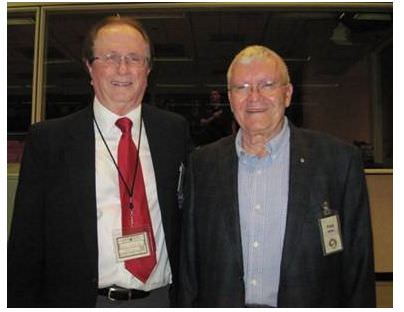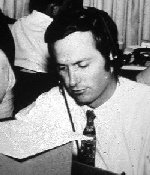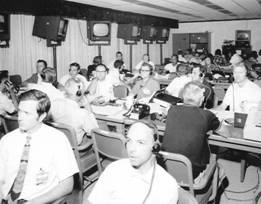“Things had gone real well up to at that point of 55 hours, 54 minutes and 53 seconds (mission elapsed time),” said Apollo 13 astronaut Fred Haise as he recounted the evening of April 13, 1970, the night the Apollo 13’s command module’s oxygen tank exploded, crippling the spacecraft and endangering the three astronauts on board.
“Mission Control had asked for a cryo-stir in the oxygen tank …and Jack threw the switches,” Haise continued. “There was a very loud bang that echoed through the metal hull, and I could hear and see metal popping in the tunnel [between the command module and the lunar lander]… There was a lot of confusion initially because the array of warning lights that were on didn’t resemble anything we have ever thought would represent a credible failure. It wasn’t like anything we were exposed to in the simulations.”
What followed was a four-day ordeal as Haise, Jim Lovell and Jack Swigert struggled to get back to Earth, as thousands of people back on Earth worked around the clock to ensure the astronauts’ safe return.

Haise described the moment of the explosion during an event in 2010 at the Smithsonian Air and Space Museum commemorating the 40th anniversary of the mission that’s been called a successful failure.
In 2010, Universe Today also commemorated the Apollo 13 anniversary with a series of articles titled “13 Things That Saved Apollo 13.” We looked at 13 different items and events that helped turn the failure into success, overcoming the odds to get the crew back home. We interviewed NASA engineer Jerry Woodfill, who helped design the alarm and warning light system for the Apollo program, which Haise described above.
Now, five years later on the 45th anniversary of Apollo 13, Woodfill returns with “13 MORE Things That Saved Apollo 13.” Over the next few weeks, we’ll look at 13 additional things that helped bring the crew home safely.

Woodfill has worked for NASA for almost 50 years as an engineer, and is one of 27 people still remaining at Johnson Space Center who were also there for the Apollo program. In the early days of Apollo, Woodfill was the project engineer for the spacecraft switches, gauges, and display and control panels, including the command ship’s warning system.
On that night in April 1970 when the oxygen tank in Apollo 13’s command module exploded, 27-year-old Woodfill sat at his console in the Mission Evaluation Room (MER) at Johnson Space Center, monitoring the caution and warning system.
“It was 9:08 pm, and I looked at the console because it flickered a few times and then I saw a master alarm come on,” Woodfill said. “Initially I thought something was wrong with the alarm system or the instrumentation, but then I heard Jack Swigert in my headset: “Houston, we’ve had a problem,” and then a few moments later, Jim Lovell said the same thing.”
Listen to the audio of communications between the crew and Mission Control at the time of the explosion:
Located in an auxiliary building, the MER housed the engineers who were experts in the spacecrafts’ systems. Should an inexplicable glitch occur, the MER team could be consulted. And when alarms starting ringing, the MER team WAS consulted.
Woodfill has written a webpage detailing the difference between the MER and Misson Control (Mission Operations Control Room, or MOCR).

The ebullient and endearing Woodfill brings a wealth of knowledge — as well as his love for public outreach for NASA — to everything he does. But also, for the past 45 years he has studied the Apollo 13 mission in intricate detail, examining all the various facets of the rescue by going through flight transcripts, debriefs, and other documents, plus he’s talked to many other people who worked during the mission. Fascinated by the turn of events and individuals involved who turned failure into success, Woodfill has come up with 13 MORE things that saved Apollo 13, in addition to the original 13 he shared with us in 2010.
Woodfill tends to downplay both his role in Apollo 13 and the significance of the MER.
“In the MER, I was never involved or central to the main events which rescued Apollo 13,” Woodfill told Universe Today. “Our group was available for mission support. We weren’t flight controllers, but we were experts. For other missions that were routine we didn’t play that big of a role, but for the Apollo 13 mission, we did play a role.”
But Apollo Flight Director Gene Kranz, also speaking at the 2010 event at the Smithsonian Air and Space Museum, has never forgotten the important role the MER team played.
“The thing that was almost miraculous here [for the rescue], was I think to a great extent, the young controllers, particularly the systems guys who basically invented the discipline of what we now call systems engineering,” Kranz said. “The way these guys all learned their business, … got to know the designs, the people and the spacecraft … and they had to translate all that into useful materials that they could use on console in real time.”

Join Universe Today in celebrating the 45th anniversary of Apollo 13 with Woodfill’s insights as we discuss each of the 13 additional turning points in the mission. And here’s a look back at the original “13 Things That Saved Apollo 13:
Part 2: The Hatch That Wouldn’t Close
Part 3: Charlie Duke’s Measles
Part 4: Using the LM for Propulsion
Part 5: Unexplained Shutdown of the Saturn V Center Engine
Part 6: Navigating by Earth’s Terminator
Part 8: The Command Module Wasn’t Severed
Part 12: Lunar Orbit Rendezvous
Part 13: The Mission Operations Team
Also:
Your Questions about Apollo 13 Answered by Jerry Woodfill (Part 1)
More Reader Questions about Apollo 13 Answered by Jerry Woodfill (part 2)
Final Round of Apollo 13 Questions Answered by Jerry Woodfill (part 3)


I wonder if one of the “13 additional things” includes the contribution of the Chabot Observatory in Oakland, California, which was the only observatory with weather clear enough to help mission control find the exact location of Apollo 13 as it flew back toward Earth. NASA needed the exact location in order to compute the timing of the final burn before Earth re-entry.